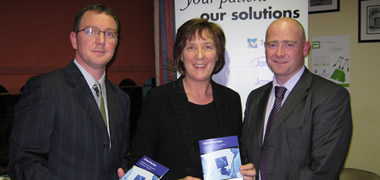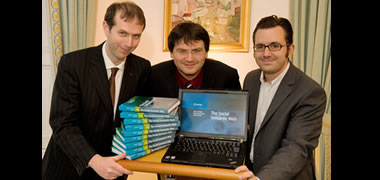-
Courses

Courses
Choosing a course is one of the most important decisions you'll ever make! View our courses and see what our students and lecturers have to say about the courses you are interested in at the links below.
-
University Life

University Life
Each year more than 4,000 choose University of Galway as their University of choice. Find out what life at University of Galway is all about here.
-
About University of Galway

About University of Galway
Since 1845, University of Galway has been sharing the highest quality teaching and research with Ireland and the world. Find out what makes our University so special – from our distinguished history to the latest news and campus developments.
-
Colleges & Schools

Colleges & Schools
University of Galway has earned international recognition as a research-led university with a commitment to top quality teaching across a range of key areas of expertise.
-
Research & Innovation

Research & Innovation
University of Galway’s vibrant research community take on some of the most pressing challenges of our times.
-
Business & Industry

Guiding Breakthrough Research at University of Galway
We explore and facilitate commercial opportunities for the research community at University of Galway, as well as facilitating industry partnership.
-
Alumni & Friends

Alumni & Friends
There are 128,000 University of Galway alumni worldwide. Stay connected to your alumni community! Join our social networks and update your details online.
-
Community Engagement

Community Engagement
At University of Galway, we believe that the best learning takes place when you apply what you learn in a real world context. That's why many of our courses include work placements or community projects.
2009
All 2009
'Boost to the Economy' as €130m Construction Plans Revealed by NUI Galway

Wednesday, 16 December 2009
NUI Galway's new Strategic Plan 2009-2014 was officially launched in Galway today (Wednesday, 16 December) by the University's President Dr James J. Browne. Key elements of the plan include a major €130m construction plan, increased numbers of spin-out companies, and a rise in numbers of mature, international and PhD students. "We are the biggest employer in Galway City, a fast growing and dynamic University, and increasingly recognised internationally for our research and scholarship", President Browne said. "Our strategic plan enshrines not only our commitment to supporting the social, economic, industrial and cultural development of the region, but our national role in supporting economic recovery. The strategic plan also cements our research ambitions which will bring further international recognition in our priority areas of expertise". NUI Galway will be a major contributor to the economy through its ambitious €130m in construction activity, which will ramp up throughout 2010. Five new buildings will be constructed, potentially creating hundreds of jobs in Galway City. Over one third of the funds for construction will come from philanthropic sources, due to intensive and very successful fundraising activity by Galway University Foundation. President Browne said the plans are a significant short-term boost to the economy and also put in place the long-term infrastructure to produce the graduates who will fuel the economic recovery to a Smart Economy. "We will play our part in revitalising the economy and developing the Smart Economy. We will do this by taking advantage of the value now available in the building industry to address our capital deficit and put in place the infrastructure to grow our research effort and our graduate output. Given that in the case of the planned research buildings the University is able to provide close to half of the cost in private philanthropic funding, we are planning significant additions to the nation's vital infrastructure at a minimal cost to the Exchequer, and ensuring the creation or preservation of hundreds of jobs in the construction industry". The new infrastructure requirements on campus stem from the rapid growth of research activity, in biomedical science for example, which directly supports the region's vital medical devices industry. Infrastructure requirements are also being fuelled by dramatic rises in student numbers. In the area of student numbers, NUI Galway's Strategic Plan sets out a target of 200 PhD graduates per year by 2014. By this time, non-traditional students will account for 7.5% of the total student population, international students for 15%, and mature students for 27%. The Strategic Plan firmly commits NUI Galway to leading the Smart Economy in the region and to its becoming a centre of innovation and enterprise for industries. Targets of a four-fold increase in patent filings, a five-fold increase in licence agreements and an average of five spin-out companies per year have been set. Online version of the Strategic Plan is available at www.nuigalway.ie/strategicplan. -Ends-
>> Read full story about 'Boost to the Economy' as €130m Construction Plans Revealed by NUI Galway
Guidelines for the Management of Diabetes in Pregnancy Booklet Launched

Tuesday, 15 December 2009
An information booklet, entitled "Clinical Practices - Guidelines for the Management of Diabetes in Pregnancy", has been launched at University Hospital Galway. The booklet is intended for use by midwives, registered nurses, obstetricians, physicians and GPs responsible for the care of women with diabetes who are pregnant or who are intending a pregnancy and for women with gestational diabetes. The guidelines, which are authored by Professor Fidelma Dunne, Head of the School of Medicine, NUI Galway and the ATLANTIC DIP research group, aim to promote high quality care and service to women with diabetes to ensure that the outcome for mother and baby matches that of non-diabetic women. In this respect, it provides a common framework to all professionals involved in the care of pregnant women at risk of, or with, gestational diabetes and those with pre-existing diabetes, type 1 and type 2. Speaking at the launch, Professor Fidelma Dunne, said: "The guidelines are an aid for professionals who deliver care to women with diabetes before, during and after pregnancy. We hope to update them on a regular basis as new information through research appears through our own work and internationally. We are also developing a booklet for patients which will be available soon. All these tools will be available on the ATLANTIC DIP website early in 2010". Diabetes is the most common medical disorder of pregnancy and complicates 1 in 200 pregnancies in Ireland. Even with the recent improvements in diabetic and obstetric care, the risk of stillbirth is 5 times and perinatal mortality is 3.5 times greater than non diabetic pregnant women. In addition, the incidence of congenital malformations remains twice the rate as for non-diabetic pregnancies. The number of women with established type 2 diabetes entering pregnancy is also on the increase and represents 25% of women with pre-gestational diabetes at antenatal clinics. Research through ATLANTIC DIP has identified that a further 1:10 women with no known diabetes, develops gestational diabetes in pregnancy. Some of the areas covered in the "Guidelines for the Management of Diabetes in Pregnancy" are: Preconceptual Care Gestational Diabetes Antenatal Care Management during Delivery Postnatal Care Care of the Newborn -Ends-
>> Read full story about Guidelines for the Management of Diabetes in Pregnancy Booklet Launched
NUI Galway's Professor Schabas Chairs UN Human Rights Board

Monday, 14 December 2009
NUI Galway's Professor William Schabas has been designated the chairperson of the Board of Trustees of the United Nations Voluntary Fund for Technical Cooperation in the Field of Human Rights. Professor Schabas is Director of the Irish Centre for Human Rights at NUI Galway and holds the Chair in Human Rights Law at the University. A world-renowned expert on international human rights law, Professor Schabas has particular expertise is in the areas of genocide and international criminal courts. The Board of Trustees is appointed by the Secretary-General of the United Nations, Ban Ki-moon. Individuals are appointed to represent the different geographic regions of the world and are chosen for their independence and wide experience in the field of human rights and technical cooperation. Commenting on the work of the five members of the Board of Trustees, the new Chair, Professor Schabas said: "The Board meets twice annually in Geneva to oversee the work of the Fund which is used to support Human Rights Advisors and Field Offices of the High Commissioner in a number of countries around the world. We also function as an advisory council for the Office of the High Commissioner for Human Rights. Many governments, including that of Ireland, contribute to the Fund, which had an income this year of $17.5 million". Professor Schabas has participated in numerous international human rights missions on behalf of non-governmental organisations such as Amnesty International and the International Federation of Human Rights, to Rwanda, Burundi, South Africa, Kenya, Uganda, Sudan, Cambodia and Guyana. In 2002, the President of Sierra Leone appointed him to the country's Truth and Reconciliation Commission upon the recommendation of Mary Robinson, the then United Nations High Commissioner for Human Rights. Professor Schabas teaches at the Irish Centre for Human Rights in NUI Galway, which has become internationally recognised in the field of human rights teaching, research and advocacy. This has enabled the institution to attract high quality students to its acclaimed MA programmes and doctoral research. Reflecting the growing interest in this field, the University has also now developed a Bachelor of Arts with Human Rights. -ends-
>> Read full story about NUI Galway's Professor Schabas Chairs UN Human Rights Board
Irish Researchers Help Solve 100-Year-Old Cosmic Mystery

Friday, 11 December 2009
Irish scientists have contributed to an important astronomical discovery published yesterday (Thursday, 10 December) in the prestigious academic magazine Nature. Scientists from NUI Galway, Galway-Mayo Institute of Technology, CIT and UCD are part of the VERITAS project which has found evidence to support the theory that cosmic rays are powered by exploding stars and stellar winds. This discovery has been predicted for almost 20 years, but until now no instrument was sensitive enough to see it. VERITAS is operated by a collaboration of more than 100 scientists from 22 different institutions in the US, Ireland, England and Canada. Using an array of four giant telescopes based at the Smithsonian Astrophysical Observatory in Arizona, the VERITAS project observed very high energy gamma radiation from the 'starburst' galaxy M82, often called the 'Cigar Galaxy'. Through deep observations of M82 the scientists made significant discoveries about cosmic rays. Scientists first detected signs of cosmic rays, which are subatomic particles that zip through space at nearly the speed of light, some 100 years ago. The challenge for astronomers, which the VERITAS project has finally succeeded in, has been to answer the question as to which natural force could accelerate particles to such high energies. Dr Gary Gillanders from the Centre of Astronomy at NUI Galway is one of the Irish scientists involved in VERITAS and a member of the VERITAS Science Board: "This discovery provides fundamental insight into the origin of cosmic rays and is an important scientific milestone in astronomy. The VERITAS observations strongly support the long-held belief that supernovae and stellar winds from massive stars are the dominant accelerators of cosmic ray particles". VERITAS could not detect M82 s cosmic rays directly but looked for clues to their presence. When cosmic rays interact with interstellar gas and radiation, they produce gamma rays, which were then detected by the VERITAS team and used to infer that cosmic rays were indeed present and being accelerated to high energies. The scientific revelation in Nature magazine is the culmination of two years of dedicated data collection and analysis by the VERITAS team. Dr Pat Moriarty, a VERITAS scientist from Galway-Mayo Institute of Technology remarked: "This project is an example of scientists at four Irish third-level Institutions collaborating in a world-class experiment". The other Irish co-investigators in VERITAS are Dr Mark Lang at NUI Galway, Dr Paul Reynolds at CIT and Dr John Quinn at UCD. The Irish VERITAS members are part funded by Science Foundation Ireland. -Ends-
>> Read full story about Irish Researchers Help Solve 100-Year-Old Cosmic Mystery
The Social Semantic Web

Wednesday, 9 December 2009
- A new book about online information - The solution to problems associated with social websites, such as information integration, dissemination and searchability are the subject of a new book by NUI Galway internet experts. The Social Semantic Web investigates how emerging Semantic Web technology has produced a variety of approaches to overcome existing information boundaries. The book is authored by John Breslin, School of Engineering and Informatics, and Alexandre Passant and Stefan Decker of the Digital Enterprise Research Institute (DERI), based at NUI Galway. The content is intended for computer science professionals, researchers, and graduates interested in understanding the technologies and research issues involved in applying Semantic Web technologies to social software. Breslin et al. describe some popular social media and social networking applications, list their strengths and limitations, and describe some applications of semantic web technology to address their current shortcomings by enhancing them with semantics. Across these social websites, they demonstrate a twofold approach for interconnecting the islands that are social websites with semantic technologies, and for powering semantic applications with rich community-created content. Practitioners and developers interested in applications such as blogs, social networks or wikis will also learn about methods for increasing the levels of automation in these forms of web communication. Co-author John Breslin, who founded boards.ie, one of the most popular internet forums in Ireland: “The ‘Social Semantic Web’, also called ‘Web 3.0’ is all about forming a network of interlinked and semantically-rich content and knowledge. This leads to a web of data that can be used by computers to help people with their daily tasks, and is an ideal platform for interlinking and performing operations on the diverse data available from Web 2.0â€. The success of much of the work described in the book has been demonstrated in its adoption by various groups and companies. The SIOC system, described in the book and developed by researchers in DERI, has been used by Yahoo! in its SearchMonkey application. It has also recently been integrated into the Drupal content management system that is used by thousands of organisations. The Social Semantic Web, is published by Springer; for more information see www.socialsemanticweb.net. -Ends-
>> Read full story about The Social Semantic Web















